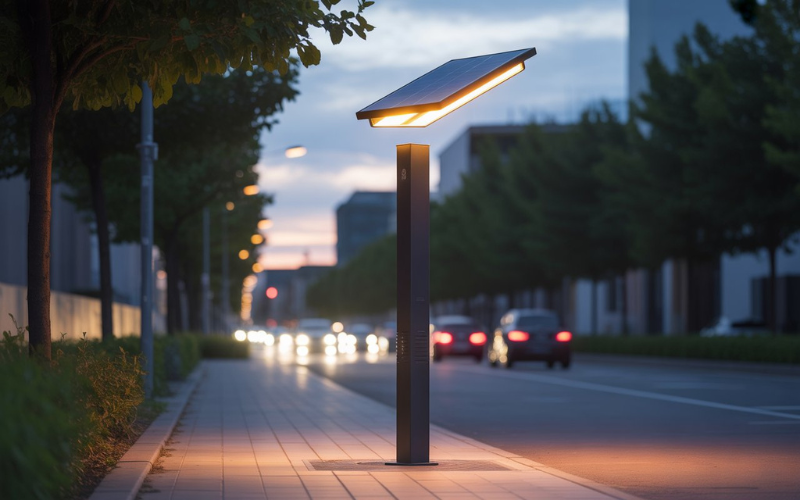
Introduction
The world is shifting toward renewable energy, and one of the best examples of this change is the solar street lamp. As cities, towns, and even rural areas look for cost-effective and eco-friendly lighting options, the solar street lamp has become a symbol of innovation, efficiency, and sustainability. Let’s explore why this technology is transforming modern lighting systems and how it benefits both the environment and communities.
Table of Contents
1. What Is a Solar Street Lamp?
A solar street lamp is an advanced lighting fixture powered entirely by solar energy. Instead of relying on traditional electricity, it captures sunlight through a solar panel during the day and stores it in a rechargeable battery. At night, the stored energy powers the LED lights, providing bright and reliable illumination.
A typical solar street light system includes:
Solar panel
LED lamp
Rechargeable battery
Controller and motion sensor
Pole and mounting structure
These components work together to provide solar street lighting that operates automatically from dusk to dawn with minimal maintenance.
2. How Does a Solar Street Lamp Work?
The operation of a solar lamp is both simple and highly efficient, relying entirely on the power of sunlight. Each system is composed of a solar panel, rechargeable battery, LED lamp, charge controller, and sensors, all integrated to ensure automatic performance with minimal human intervention.
Daytime Charging
During the day, the solar panel—usually made of high-efficiency monocrystalline or polycrystalline silicon cells—captures sunlight and converts it into direct current (DC) electricity through the photovoltaic effect. This energy is then stored in the rechargeable battery, most commonly a lithium-ion or lithium iron phosphate (LiFePO₄) type, known for its long lifespan and deep discharge capacity. The charge controller plays a vital role here, regulating voltage and current flow to prevent overcharging and battery damage.
Automatic Lighting at Night
As evening approaches and sunlight intensity decreases, the built-in light sensors detect the drop in brightness. The controller automatically activates the LED lamp, drawing power from the stored energy in the battery. Modern solar street lamps often include motion sensors, which adjust the light intensity based on activity nearby—brightening when movement is detected and dimming during inactivity to conserve energy.
Dawn Shut-Off and Recharging
At sunrise, the sensors recognize the return of daylight and switch off the LED lamp automatically. The system then resumes its charging cycle. This fully automated process ensures reliable, continuous operation without manual supervision, making solar street lamps ideal for remote or off-grid areas where electricity is unavailable or inconsistent.
3. Advantages of Using Solar Street Lamps
Switching to solar-powered street lighting offers numerous economic, environmental, and operational advantages.
Energy Saving and Cost Efficiency
Solar lamps use free, renewable sunlight, eliminating electricity bills. After installation, the ongoing operational cost is minimal, and the system often pays for itself within a few years through energy savings.
Low Maintenance and Easy Installation
Because there are no underground cables or external power sources, installation is quick and straightforward. The durable components require little maintenance—only occasional cleaning and periodic battery checks.
Reliable Performance
Even during power outages or in remote areas, solar street lamps provide consistent and dependable illumination, enhancing safety and community life without straining local power grids.

4. Types of Solar Street Lamps
There are several types of solar street lamps, each designed for specific environments and needs:
a. All-in-One Solar Street Light
An all-in-one solar street light combines the panel, LED, battery, and controller in a single compact unit. It’s lightweight, easy to install, and perfect for residential and urban areas.
b. Integrated Solar Street Lamp
An integrated solar street lamp offers improved efficiency by combining advanced technology in one body, providing higher brightness and longer battery life.
c. Solar Street Lamp with Motion Sensor
This model includes smart sensors that adjust brightness based on movement. A solar street lamp motion sensor saves power and enhances security in public areas.
5. Applications of Solar Street Lamps
Solar street lamps are versatile and can be installed in various locations:
Highways and solar road lights
Parking lots and pathways
Residential streets and gardens
Parks, campuses, and playgrounds
Rural areas and off-grid locations
Because of their reliability and energy efficiency, solar LED street lamps are now common in both developed and developing countries.
6. Choosing the Right Solar Street Lamp
Selecting the right solar street lamp is essential to ensure optimal performance, durability, and energy efficiency. Several key factors should be considered before making a purchase or installation decision.
Brightness Requirement
The brightness of a solar street lamp is measured in lumens. For residential streets and pathways, 1,000–3,000 lumens are sufficient, while highways or large public areas may require 5,000 lumens or more. Choosing the correct brightness ensures proper visibility and safety without wasting energy.
Battery Capacity
The battery stores the solar energy collected during the day. Lithium-ion or LiFePO₄ batteries are the preferred options due to their longer lifespan, faster charging, and higher efficiency compared to lead-acid batteries. A high-capacity battery ensures the light operates reliably through cloudy days or long nights.
Solar Panel Efficiency
The solar panel type greatly affects energy generation. Monocrystalline panels are more efficient and durable than polycrystalline ones, especially in low-light conditions. Choosing panels with high conversion efficiency ensures better charging and consistent performance.
Pole Height and Design
The height and design of the pole should match the lighting coverage area and the surrounding environment. Taller poles cover wider spaces, while shorter ones are ideal for walkways or gardens.
Weather Resistance
For long-term use, select lamps made from waterproof, rustproof, and corrosion-resistant materials. A well-chosen solar street lamp can last over 10 years, providing sustainable and reliable lighting in all weather conditions.

7. Installation and Maintenance Tips
Although solar street lights are easy to install, following best practices ensures long-term efficiency:
Place the solar panel in a direction that receives maximum sunlight.
Clean panels regularly to remove dust and debris.
Check wiring and battery connections periodically.
Replace old batteries after 3–5 years to maintain brightness.
Avoid shading from trees or buildings.
Because the solar street lighting system works independently, installation costs are lower than traditional electric lights.
8. Cost and Return on Investment
While the initial cost of a solar lamp might seem high, the long-term savings are significant. Let’s break it down:
Zero Energy Costs: Once installed, sunlight is free.
Minimal Maintenance: Reduced labor and repair expenses.
Government Incentives: Many regions offer subsidies for solar installations.
Durability: LED bulbs and panels last up to 50,000 hours or more.
Within 2–4 years, the investment in a solar street light system typically pays for itself through reduced energy and maintenance expenses.
9. The Future of Solar Street Lighting
The literally and figuratively. Innovations such as smart sensors, remote monitoring, and AI-based controls are making solar LED street lamps even more efficient. Cities are integrating these systems into smart grids, reducing energy waste and improving safety.
In developing countries, the adoption of solar street lamps is transforming lives—providing safe, well-lit streets that promote community activities and reduce crime rates. Future models will likely include faster-charging panels, longer battery life, and adaptable brightness controls.

Conclusion
Solar street lamps represent a significant step forward in the global transition toward renewable and sustainable energy solutions. By harnessing the free and abundant power of the sun, these systems provide reliable, cost-effective, and environmentally friendly lighting for streets, parks, campuses, and remote areas.
With advancements in battery storage, LED efficiency, and smart sensor technology, modern solar street lamps offer powerful illumination with minimal maintenance. Their automatic operation—from charging during the day to lighting up at night—ensures consistent performance in all conditions.
FAQs
1. How long does a solar street lamp last?
A high-quality solar street lamp can last 10–15 years, depending on the components. The LED light typically lasts over 50,000 hours, while the battery may need replacement every 3–5 years.
2. Do solar street lamps work during cloudy or rainy days?
Yes. Solar street lamps store excess energy in their batteries, allowing them to function for 2–3 nights even with limited sunlight. However, efficiency may slightly decrease during extended cloudy periods.
3. What type of battery is best for solar street lamps?
Lithium-ion or LiFePO₄ (Lithium Iron Phosphate) batteries are the best options due to their long lifespan, fast charging, and deep discharge cycles compared to traditional lead-acid batteries.
4. How bright are solar street lamps?
Brightness depends on the model and its lumen output. Standard solar street lights range from 1,000 to 10,000 lumens, suitable for anything from residential areas to highways.
5. Can solar street lamps work without direct sunlight?
They require sunlight to charge efficiently, but they can still generate some power under indirect sunlight or overcast conditions—though at reduced capacity.




